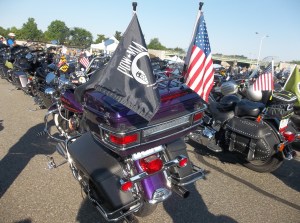It was a long 4 months. Sometimes very long. And heart-wrenching. And troubling. And emotional. Very, very emotional. Mary’s and my intensive, exhaustive study of the Vietnam conflict made us both examine our thoughts and feelings on that conflict from every possible angle – first, that of the Vietnamese people, followed by those of the soldiers (referring here to personnel from all branches of our military, not just the Army, with apologies to airmen, sailors, and marines), the protestors, and perhaps, a little of the government.
Our study involved reading several books, covering everything from protestors to POWs to soldiers in-country, soldiers at home, and where the Vietnamese actually came into play in this whole nasty war. We watched over 15 hours of documentaries that covered everything from the first Vietnam war against Imperialist France all the way through to the pouring of refugees into the US in 1975. We saw a display at a museum on items from the conflict, including a bamboo tiger cage (used to house POWs in the South Vietnamese jungles). We saw a play about the Wall, and we met and spoke with the producer of that play, himself a Vietnam vet. At the end of our study, we determined that the US treated the South Vietnamese poorly, and the US government and a portion of its citizenry treated the soldiers both poorly and unfairly.
We agreed that muddling through the politics as the US entered the conflict was worse than trying to untangle yarn barf. Mary at one point asked, “The US supported Communism?!” That led to a discussion about what it means when we say, “the enemy of my enemy is my friend.” Our hearts broke over the images of dead children, especially following the My Lai massacre, and we grieved for the Vietnamese people who have only ever yearned for independence from foreign powers, only to be oppressed by their own Communist government. As my teachers had been quite determined to avoid all mention of the very politically-charged and -incorrect Vietnam Conflict, this was a tremendous learning experience for both of us.
Those four months led to this…
“This” is Rolling Thunder XXVIII, which was Sunday, 24 May, 2015, in Washington, DC. Rolling Thunder is a non-profit organization that lobbies to keep the focus on the soldiers who are still MIA from WWII, Korea, and Vietnam. Their organization is named after Operation Rolling Thunder, a massive air offensive against the North Vietnamese Army (NVA) during the conflict. It was fascinating to learn that, while Mary and my Dad and his motorcycle group were in DC, the remains of 10 who’d been MIA were found in Laos, and one has been identified thus far. Mary went with Dad to help minister through simple cups of water.

Some of the approximately 900,000 bikes that greeted the sunrise on Sunday at Rolling Thunder XXVIII
Before she went to DC to encounter those who still may carry their scars from the conflict – either physical, mental, or emotional – Dad wanted her to understand the conflict in which they fought and the battles they encountered. These weren’t just battles of bombs, knives, guns, and bayonets; these were battles against disease; the loss of comrades-in-arms, friends, or relatives; and the battles at home against an unappreciative country, uncomprehending families, and PTSD.
Mary was simply Mary. She went up there knowing that vets appreciate being thanked for their service, and she did. The first time she did so, he nearly cried. She helped. She served water. She smiled and thanked and brought her own light to people. She showed the love of Christ to men who were considered “the least of these” – “scum,” “murderers,” “baby killers” – 40 years ago. She knows the ugly side of the conflict; she knows innocent people died. That’s the greatly unfortunate part of every war and conflict, and those soldiers responsible for those deaths – we call them “collateral damage” today – bear the scars on their hearts and souls. These soldiers were kids back then, off the farm or out of the city, who had been called up to fight in a conflict they didn’t understand in a land that was completely unknown to them. Still, Mary didn’t consider their past. She spoke to people, not knowing if they took lives or how many. She looked at them in the present.
No one wants to learn about the Vietnam Conflict today. It’s terribly unpopular still, and frankly, it’s still a big, nasty mess to study. It’s uncomfortable to study. The truth is, the US did at one time support a communist country. The truth is, American troops did massacre innocent seniors, women, and children at My Lai. And, it’s my opinion that we did treat the South Vietnamese unfairly. So many of the Vietnamese refugees still long to return home to a democratic government free of communism. Freedom is great, but nothing quite satisfies the soul like being home.
For all its ugliness, I’m grateful for this study. I’m grateful for the ways in which this exhaustive exploration of the conflict stretched our minds and our compassion. I’m grateful that Mary and I both came through it with a new respect for what these Vietnam vets endured, both in battle and at home. For us, there is a whole new appreciation for those who never made it home, who made the ultimate sacrifice in their efforts to ensure that those who dodged the draft, burned their draft cards, protested – even to the point of committing treason were it not for the legal hamstringing of the Gulf of Tonkin Resolution – and took every deferment available maintained the right to express their displeasure of the conflict.
We are grateful. You are not forgotten.











Knowledge leads to compassion.
LikeLike
Yes, it does. The heart hurts of the study were well worth the compassionate insights we gained.
LikeLike